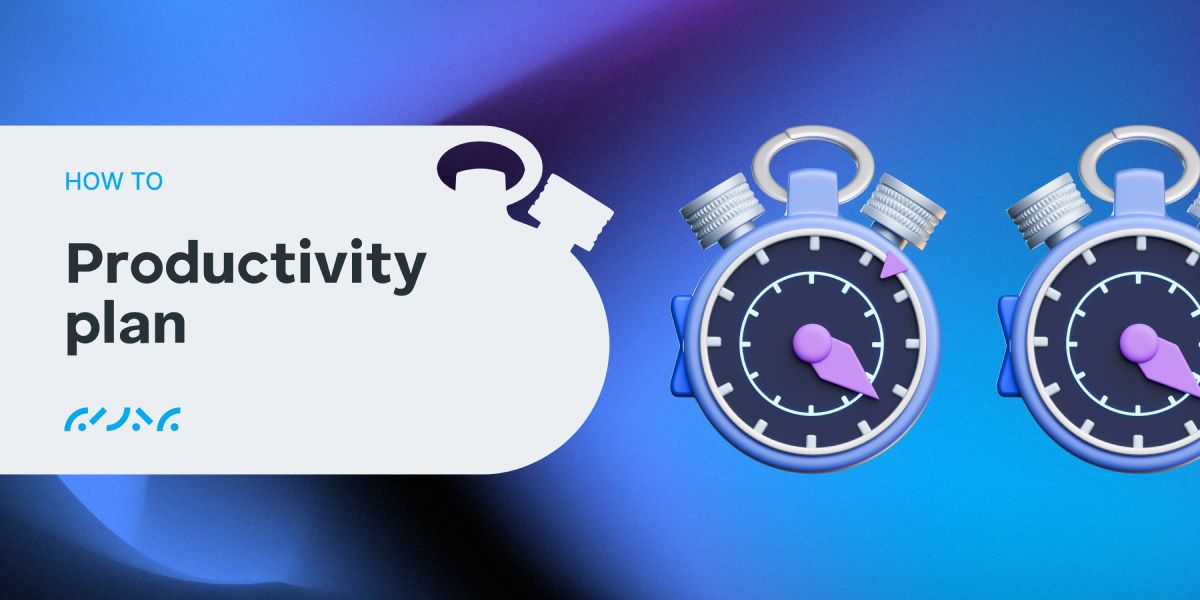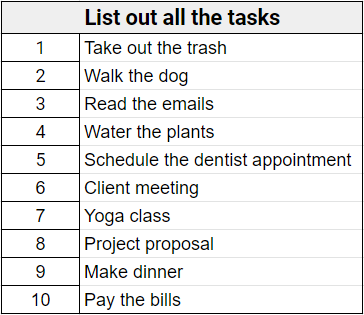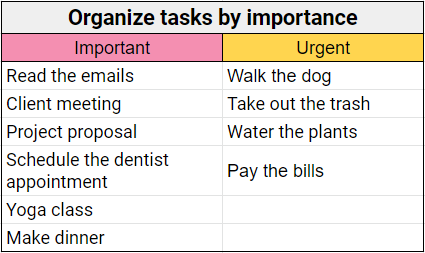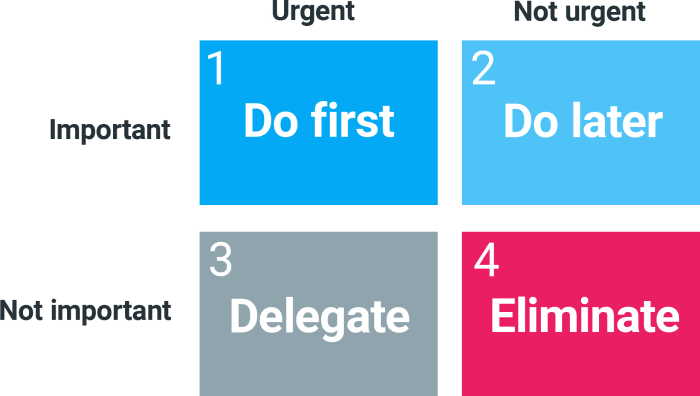To the majority of us, productivity doesn’t come naturally. Accomplishing everything effortlessly is just not who I am as a person.
However, everything can get done if you make an effort to think ahead and get organized. Just as success, productivity starts with a plan.
Do you know how to make a plan that will maximize your productivity? If you don’t – you’re in the right place. (But even if you do, stay with us, you may learn something new!)
In this article, we’ll show you how to make a productivity improvement plan — from getting into the right mindset to execution and practical tips.

Table of Contents
What is a productivity plan? And why is it important you make one?
Simply put, a productivity plan is a unique plan you make to boost your effectiveness. It consists of your priority tasks scheduled in an optimal way. That means that you need to include all your essential assignments in a productivity plan while paying attention to leave some buffer (for urgent tasks that may appear).
So, why is it important to make productivity plans? Well, these documents can help you:
- Organize your assignments,
- Distinguish between significant and non-significant tasks,
- Be better at decision-making, and
- Align your long-term goals with short-term ones.
You can create a productivity improvement plan for an entire week. Weekly productivity plans allow you to structure your week more effectively and ensure that you won’t miss any significant tasks or activities.
Then again, maybe you prefer crafting your plans day by day. In that case, you can take some time to create a productivity plan first thing in the morning or the night before.
No matter what type you choose, be sure that everything starts from the mind, so let’s first see how to get into a productivity mindset.
Get into the right mindset for productivity
Before you start creating your productivity plans, get your head in the game. If you want to build something that will stand the test of time, you have to make sure the foundation is of good quality. Your thoughts become your words, your words become your actions, your actions become your habits… you know the deal.
The first step towards the right mindset is the awareness that being productive doesn’t equal being busy. Let’s learn more about the difference between busyness and productivity.
Are you busy?
Many studies have proven that busy culture hinders productivity and even causes career burnout.
In one HBR article on busyness and its correlation to burnout, the author talks about the busyness paradox. So, when we’re busy, we can only focus our attention on the most immediate tasks, which are often low-value ones. This phenomenon is known as “tunneling”. We feel like we’re in a tunnel and are only able to see tasks in front of us, thus, the most immediate ones. As a result, we usually don’t have enough time to deal with significant assignments, therefore, we’re not as productive as we’d like to be. Moreover, having no time to work on your vital tasks keeps you away from meeting your long-term goals.
Are you productive?
On the other hand, being productive means that you make the best use out of your time and energy. It’s more focused on quality (getting results) than quantity (spending a lot of time working).
Well, how should you avoid busyness and regain productivity? Here are several ways to be productive:
- Try to aim your attention at one task at a time. Trust us, it’ll be so much easier to complete your tasks. In contrast, multitasking, or switching between projects and tasks, can only make you look extremely busy. But, in reality, you’ll only waste your precious time.
- Always take breaks to clear your mind. “Tunneling” your way through the day without any rest can be exhausting. So, get out of a tunnel, recharge your mind for a couple of minutes, then get back to work. You’ll surely be able to properly figure out what tasks are crucial at the moment and what aren’t.
- Learn to say “No”. If you’re dealing with unrealistic deadlines or you’re already swamped with assignments, don’t be afraid to politely say “No” at work. This way, you’ll save time for your priority tasks.
Now that we’ve distinguished between productivity and being busy, let’s dive deeper into a productive mindset.
The most important aspects of a productivity mindset
The productivity mindset consists of a few different aspects:
- A vision,
- Discipline,
- (Intrinsic) motivation,
- Critical and strategic thinking,
- Open-mindedness and willingness to learn, and
- Self-confidence and positive attitude.
Now, let’s see why each of these aspects is crucial for developing a productivity mindset.
A vision
You have to know what exactly you want — only then will you be able to set adequate goals and create a good strategy.
Having a clear vision in your mind means knowing what your end goals are. Then, all you need to do is make sure you give your best every day to get a bit closer to your long-term goals. So, once you figure out your yearly objectives, you should break them down into monthly, then weekly, and daily goals.
For instance, if you’d like to participate in a marathon next year, the only way to accomplish this vision is to make a detailed strategy and align this long-term goal with your daily targets. In this case, daily goals can be cardio and strength exercises for one hour each.
Discipline
How often are you truly motivated to work?
Even though I love my job, I’m absolutely not feeling motivated every business day from 9 to 5. I also can’t afford to wait for the muses of motivation and inspiration to bless me with their presence, at least not if I aim to pay my bills for the month.
That’s where discipline comes in. Successful people are able to delay gratification and get things done even when they’d rather do something more fun.
What traits do highly disciplined people have in common? Well, these qualities are usually a sense of responsibility, persistence, strong work ethic, and self-care. Thus, cultivating these characteristics can surely help you be more disciplined.
(Intrinsic) motivation
To be disciplined for more than a few days, you have to know your “Why?”. Why are you doing what you’re doing? The motivation we get from inspirational quotes won’t carry us far, but intrinsic motivation will. As noted in one Psychology Today article, “intrinsic motivation is like an endless wellspring. It drives behavior from within.” Thanks to this type of motivation, we do things that are enjoyable without expecting any rewards. Besides, intrinsic motivation will also help you stay persistent even when things get hard.
Critical and strategic thinking
Look at things coming your way objectively, rationally, and from different perspectives. To improve your critical thinking, you should:
- Keep your long-term goals in mind and think about the ways you can achieve them.
- Enhance your problem-solving skills. This way, you’ll ensure that the decisions you make are aligned with both your short-term and long-term targets.
- Think outside the box. Whenever you’re dealing with complex tasks, be sure to consider assignments from diverse perspectives.
Being able to think strategically will help you solve issues with ease, which will also enhance your productivity levels.
Open-mindedness and willingness to learn
You need these qualities to improve not only your work but yourself too.
When you’re open-minded, you find it easier to think of new ideas, which can be quite helpful in the workplace but also in everyday life. Besides, open-minded people are usually good at problem-solving since they’re able to approach any issue from diverse perspectives.
In addition, when you’re eager to gain knowledge, you’ll always be willing to stay ahead of the curve in adopting new skills. In fact, according to Carol Dweck, a psychologist interested in human motivation, there are two types of mindsets:
- Fixed mindset — intelligence is fixed. For example, people who want to look smart usually tend to give up easily and stay away from challenges.
- Growth mindset — intelligence can be cultivated. For instance, people who are eager to learn are usually not intimidated by challenges and are willing to carry on when faced with obstacles.
So, give your best to nourish a growth mindset.
The better you get with these traits, the more effective you get, and as a consequence, the more productive you get.
Self-confidence and a positive attitude
Last but not least, you must believe in yourself. As the famous Henry Ford’s quote goes, “Whether you think you can, or you think you can’t — you’re right.”
You have to somehow convince yourself that you’re capable of doing everything you need to do and that you can do it very well (which may not be an easy thing to do – but I believe in you).
Make a productivity plan in 5 steps
When we set the right foundation, it’s time to take action. Here are vital steps you need to take to build a productivity improvement plan.
1. List out all the tasks you need to do
Brain-dump everything that comes to your mind, whether it’s a big project or an everyday chore like taking out the trash. Don’t worry about prioritization, for now, you’ll do it in the next step.

2. Organize tasks by importance
What tasks will get you the furthest in achieving your goals? What tasks will have the biggest consequences if they don’t get done? What tasks are the most urgent?
Here’s an example of how you can break your tasks into two categories: important and urgent. These activities include both work tasks and your daily chores.
We also covered several strategies that can help you with your prioritization.

Organize tasks with the Eisenhower Matrix technique
Another way to distinguish your tasks by urgency and importance is to try the Eisenhower Matrix technique. To use this method, you need to divide your assignments into four quadrants:
- The first quadrant: Important and urgent tasks.
- The second quadrant: Important but not urgent tasks.
- The third quadrant: Unimportant urgent tasks.
- The fourth quadrant: Unimportant tasks that are not urgent.
This time management technique can help you evaluate your tasks and decide what the most crucial ones are. Besides, you’ll be able to reconsider what is urgent and what isn’t.

Organize tasks with Warren Buffett’s “2 Lists” strategy
Aside from the Eisenhower Matrix technique, here’s another strategy you can use to organize your tasks — Warren Buffett’s “2 Lists” method.
So, what’s the story behind this action?
Warren Buffett uses a simple “2 Lists” strategy to help his employees figure out their priorities and actions. This action can maximize your focus and provide you with a better understanding of your priorities.
Here’s how it all started. When Buffett was talking with his personal pilot, Mike Flint, they touched on the topic of Flint’s career priorities. Buffett asked him to go through a 3-step exercise:
- He asked him to write down his top 25 career priorities.
- After that, Flint had to review the list and circle his top 5 priorities.
- He ended up with two lists: List 1, with his circled top 5 goals, and List 2, with 20 other goals.
As Flint said he would start working on the top 5 immediately, Buffett proposed a question: “And what about the ones you didn’t circle?”
“Well, the top 5 are my primary focus, but the other 20 come in a close second. They are still important so I’ll work on those intermittently as I see fit. They are not as urgent, but I still plan to give them a dedicated effort.”
Buffett replied: “No. You’ve got it wrong, Mike. Everything you didn’t circle just became your Avoid-At-All-Cost list. No matter what, these things get no attention from you until you’ve succeeded with your top 5.”
3. Find a productivity strategy that works best for you
Now that we’ve prioritized our tasks, it’s time to figure out the best productivity strategy for creating a plan. The importance of a proper strategy is that it helps you stay on track with your goals.
We’ll cover several popular strategies you can use:
- Anthony Trollope’s strategy,
- The Ivy Lee method, and
- Pareto principle (The 80/20 Rule).
Try to find the one that will fit your lifestyle and make your productivity planning go smoother.
Anthony Trollope’s strategy for working on big projects
We talked multiple times in multiple different articles about how the most important task should be done first. But what if that first task is really big, takes way too long, and frustrates you? Let’s look at what Anthony Trollope has to say on the topic.
Trollope is a prolific English novelist. Writing, let alone writing novels, can take a long time and get disheartening.
Trollope had a solution: instead of measuring his progress based on the completion of chapters, he measured his progress in 15-minutes time intervals. It allowed him to feel a sense of accomplishment and get an immediate payoff.
Here’s how Trollope explained his strategy in the book Daily Rituals: How Artists Work, by Mason Currey:
“It had at this time become my custom, — and is still my custom, though of late I have become a little lenient of myself — to write with my watch before me, and to require of myself 250 words every quarter of an hour…
This division of time allowed me to produce over ten pages of an ordinary novel volume a day, and if kept up through ten months, would have given as its results three novels of three volumes each in the year…”
So, by measuring your progress frequently, you’ll have a better sense of achievement, and thus, you’ll be motivated to carry on with your performance.
The Ivy Lee method
Ivy Lee was a productivity consultant who worked for Charles M. Schwab, the CEO of Bethlehem Steel Corporation. Lee’s job was to enhance the company’s efficiency. With a long history, the Ivy Lee method dates back to 1918, and it may be a good choice if you’re a beginner at creating productivity plans. The method is simple — so simple that it raises suspicion of its effectiveness. But maybe its simplicity is the reason it’s so effective?
- At the end of every workday, write down 6 tasks you need to accomplish tomorrow.
- Organize them in order of their true importance.
- When you arrive at work, focus on the first task. Work until the task is finished, then move to the second one.
- Work through the rest of your list in the same fashion. If you don’t manage to finish all of them, move the unfinished tasks to tomorrow’s list.
- Repeat.
Pareto principle (The 80/20 Rule)
Pareto principle is not a law, but an observation that most things in life are not distributed evenly. It stemmed from an observation that 80% of the wealth in Italy belonged to 20% of the population.
In his article on the 80/20 rule, Brian Tracy, a motivational speaker and the author of Eat That Frog, mentioned two terms: “vital few” and “trivial many”. These terms were coined by the Pareto principle’s founder, Vilfredo Pareto, who claimed that in any society, these “vital few” are people who belong to 20% of the population, regarding money and influence. The “trivial many” belong to the majority of the population.
Here are some examples of the 80/20 rule:
- 20% of our activities make 80% of the result.
- 20% of customers make 80% of the revenue.
- 20% of causes make 80% of the circumstances.
Additional example: remember when you were doing group projects in school and one person would always do the majority of the work? Yep, that’s the Pareto principle.
What does that mean for us and how to apply it?
Find what are those key 20% activities that make the difference for you and focus on them. Our time and energy are limited resources and should be used wisely.
4. Note your time
Figure out how much time you need for each task and how much you have in total (an afternoon, a week, a month). If you don’t know how much time each of your tasks takes (most of us don’t, it’s hard to estimate accurately when you’re immersed in work), try tracking your time with an app such as Clockify.
It couldn’t be more simple: start a timer when you begin a certain activity and stop the timer when you finish. If your activities are digital, you can use an automatic time tracker and make things even easier — you don’t have to do anything, the app will automatically track your activity. After using it for a while, you’ll have a clearer picture of how you spend your time and how much time every task usually takes. That data is crucial when you’re making (new and improved) productivity plans.
In the screenshot above, you can see a productivity timeline, a record of the time you tracked by using an automatic time app. This timeline shows how you spent your day and what apps you used. The plus sign at the right allows you to add each activity you’d like to include in your time records. By reviewing timelines such as this one, you’ll have a better idea of whether you spend too much time on some activities. Thus, you’ll be able to improve your productivity plans.
A user of Clockify noted: “I love how seamlessly and with ease I can track my time to better support business productivity and planning. I like how many users I can track and the way the reports show how time is used.”
5. Make an optimal schedule
When I was in school, I prepared for quizzes and exams by counting how many days I had left and how many pages/chapters I needed to learn. I would make a study plan by dividing the number of pages by the number of days. The fourth step of developing a productivity improvement plan is essentially a grown-up version of this. Take into account everything you gathered in the last step and make an optimal schedule. To maximize your productivity, have in mind your natural rhythm (Are you a morning person? Or a night owl?) and schedule the most important task(s) when your focus is at its peak.
Be realistic, though. Leave a buffer, just in case. Take into consideration that something unplanned might happen. Your cat may unexpectedly throw up on the carpet so you’ll need to clean that up and take the carpet to get cleaned. Or you may have one of those days when it seems you can’t do anything right. Don’t leave too much time (Parkinson’s law!) but, on the other hand, make sure you leave enough, so you won’t have to rush and/or panic.
💡 Parkinson’s law is the adage that “work expands to fill the time allotted”. For example, if you give yourself a week to complete the task, it will take you a week, but if you give yourself 3 days, you’ll manage to complete the same task in 3 days.
Read more about Parkinson’s law here:
Additional tips to make productivity planning easier
Here are some additional tips to make productivity planning easier. Good habits go hand in hand with being productive, so that’s what these tips are mostly focused on.
Work in a cooler room
Your workplace of choice shouldn’t be warm and cozy.
That environment makes you relaxed and sleepy, which is the exact opposite of what you need if you want to be productive. Your mind should be focused and awake, and a slightly cooler room helps with that.
Notice that I said slightly. You shouldn’t be uncomfortable and cold either. Ideally, all of your needs should be met so you can completely concentrate on your tasks.
Track your progress visually
In 1993, Trent Dyrsmid was a 23-year-old stockbroker in a bank in Abbotsford, Canada. Due to his age and the fact that Abbotsford isn’t exactly the place where big business deals were made, no one expected Dyrsmid to be as incredible as he was.
Within 18 months, he brought 5 million dollars to the company and started earning 6 figures (in today’s money) by the age of 24.
How?
James Clear explained Dyrsmid’s success in his book Atomic Habits. So, here’s how the story goes. Dyrsmid had two jars on his desk. When he made a sales call, Dyrsmid would move a paper clip from the full jar to the empty one. “Every morning I would start with 120 paper clips in one jar and I would keep dialing the phone until I had moved them all to the second jar,” he said.
One of the reasons this worked so well is because it gave him a visual clue of his progress. Each moved paperclip gave him a little satisfaction and motivation that pushed him further.
Just like this method, habit trackers function in the same way. They visually show you your progress, but not only that; the longer you track your progress, the longer your streak gets, and the worse it feels to break it. The thought of “I don’t want to break my streak, I’ve been doing so well” motivates more than you might think.
Use the 2-Minute Rule to develop good habits
James Clear is also famous for creating a 2-minute rule that states: “When you start a new habit, it should take less than two minutes to do.” It’s inspired by David Allen and Getting Things Done, whose version states “If it takes less than two minutes, then do it now.”
The idea is to make habits as easy as possible to start. That’s the hardest part — when you start doing it, it’s not that bad. We all learned Newton’s law of motion in school: “a body at rest tends to stay at rest, and a body in motion tends to stay in motion, unless acted on by a net external force.”
In this case, we don’t have external force, only internal, and we create it by focusing on the very next step (that will take 2 minutes or less).
If you want to start reading more, start with reading just one page.
Start working out by putting on your workout clothes.
Start folding your laundry by folding just one piece of clothing.
That’s doable, right?
Conclusion
You make productivity plans by listing all of your tasks, prioritizing them, and using the time tracking data to make a perfect schedule. You can also try productivity strategies made by someone else, if they fit your lifestyle – after all, you may pick up some tricks that you can use for your own strategy.
Knowing what you’re doing in advance is important, however, even the most elaborate plan doesn’t mean much if there’s no execution. The way to improve your current productivity plan is also by doing – seeing what works and what doesn’t and making changes accordingly.
Keep in mind that the most important step of any plan is taking action.
✉️ Have you tried making productivity plans? If so, do you find them useful for organizing your professional and personal activities? Share your insights with us at blogfeedback@clockify.me for a chance to be featured in this or future posts.



